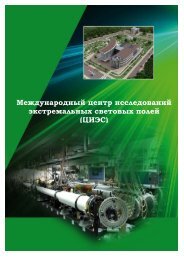Exawatt Center for Extreme Light Studies (XCELS)
Exawatt Center for Extreme Light Studies (XCELS)
Exawatt Center for Extreme Light Studies (XCELS)
You also want an ePaper? Increase the reach of your titles
YUMPU automatically turns print PDFs into web optimized ePapers that Google loves.
3<br />
(UK), <strong>Center</strong> <strong>for</strong> Antiproton and Ion Research FAIR (Germany), National Research<br />
Institute of Canada. It is supposed that the main contribution of <strong>for</strong>eign partners will be<br />
supply of high-tech research equipment <strong>for</strong> the laser complex and research laboratories,<br />
totaling about 15% of the Project cost.<br />
Currently, the most important <strong>for</strong>eign contributions to the development of the <strong>XCELS</strong><br />
Project are made by France. In 2009, Russia and France signed the international<br />
agreement on the development of research on extreme laser fields ELISA which<br />
stimulated development of the <strong>XCELS</strong> Project. In 2011, the Ministry of Education and<br />
Science of France organized the new international institute IZEST (International Institute<br />
<strong>for</strong> Zettawatt-<strong>Exawatt</strong> Science and Technology) to provide scientific and scientificorganizational<br />
support of projects aimed at developing exawatt power lasers and their<br />
applications. <strong>XCELS</strong> is regarded by this institute as a major research project that will play<br />
a decisive role in the development of the corresponding field of knowledge in the next<br />
decade. This initiative has been supported by the largest research laboratories wishing to<br />
collaborate with IZEST and <strong>XCELS</strong>.<br />
The <strong>XCELS</strong> Project is also supported by the leading international organization on the<br />
creation and use of ultra intense lasers ICUIL (International Committee on Ultra Intense<br />
Lasers), which coordinates the activities of the major laser labs around the world.<br />
Negotiations on cooperation under the <strong>XCELS</strong> Project are initiated with the heads of<br />
the European infrastructure project ELI and representatives of the European Commission.<br />
The ELI project, which aims at creating and using sources of extreme light fields has<br />
successfully completed the preparatory phase, in which 13 European states participated.<br />
By the results of the preparatory phase, the European Commission made a decision to<br />
build in 2011-2016 three new laser centers with sources having power of about 10 PW in<br />
Hungary, the Czech Republic and Romania with the cost of construction of each of about<br />
280 million euros. The facility that will be built in Hungary is intended <strong>for</strong> research on the<br />
generation and use of attosecond pulses. The facility constructed in the Czech Republic<br />
will be used to develop laser-plasma accelerators and new sources of X-ray and gamma<br />
radiation. In Romania, the facility will be intended <strong>for</strong> conducting research in the field of<br />
photonuclear physics. <strong>XCELS</strong> will naturally be of interest <strong>for</strong> international cooperation with<br />
the ELI consortium on extreme laser fields, as it will have a laser source of the next<br />
generation and a research program using fields that are not available in other research<br />
centers.



